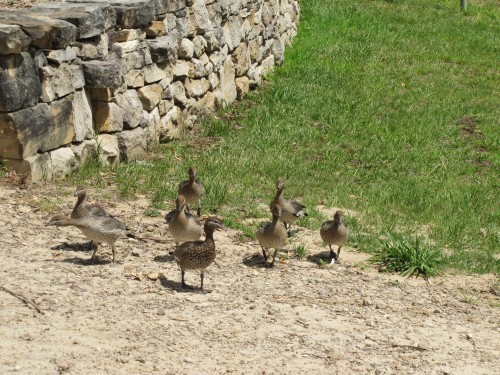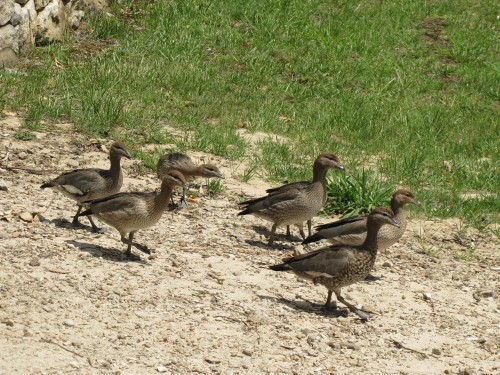A family outing
It is quite a common sight to see small flocks of Australian Wood Ducks in many places around Australia where they occur. Sometimes they even gather in loose flocks of many dozens – even hundreds. They are often seen grazing on grasslands, ovals, lawned areas in parklands and along water courses, lakes and wetlands.
The group shown in today’s photos were seen near a watercourse in the Mt Annan Botanic Gardens in the Sydney suburb of Campbelltown. It appears to be a family group with the mother leading the way and all the offspring following. The gardens see many hundreds of visitors daily, so these birds – even the younger one – were not all concerned by our presence. I’ve experienced that lack of timidity in this species when visiting other parks and gardens. It certainly makes photography much easier when the birds hang around – almost as if they are posing deliberately for my camera!
Mallards in Meknes, Morocco
During our tour of Meknes in Morocco we visited a beautiful golf course inside a fortress in the heart of the city. There was a large pond as a part of the landscaping of the golf course. I saw a few ducks on this pond, including several Mallards.
This was one species I didn’t see all that often in Morocco, but that probably just reflects the fact that our tour didn’t take us to many places where there was suitable habitat. Ours was more of a cultural tour; any birding was merely incidental. One day I hope to return and do more of an environmental tour, taking in natural habitats where the bird life is more prevalent.
There was another species of duck present, but I couldn’t identify it.
Grey Heron, Meknes, Morocco
In Meknes we walked past this rectangular reservoir in the heart of the city. When I saw the water I was eager with anticipation at seeing some of the water birds of Morocco. I was disappointed.
On a structure way out in the middle was a solitary Grey heron accompanied by one unidentified duck. Grey Herons are widespread in Africa, Europe and Asia but don’t occur here in Australia, so this one bird was a new species for me. I never saw another one on our trip. Birding can be like that; exciting one day, disappointing the next.
The photos are disappointing too, but it was not surprising because the birds were over one hundred metres away so I was really stretching the capabilities of the zoom lens.
Ducklings off for a swim
On a recent visit to Clare late last year I took off about a half hour from helping my daughter in her garden and took a five minute walk down the road to Lake Inchiquin. Yesterday I wrote about some of the birds I saw.
One of the highlights was this little family of Pacific Black Ducks. From the size of the ducklings I’d say that they are about half grown. It was a lovely sight and they let me come to within a few metres of them.
I guess they knew that I wouldn’t dive in and harm them in any way.
A little birding in Clare
Last December we visited our daughter who teaches in Clare in the mid-north of South Australia. One afternoon I wandered down the road to Lake Inchiquin which is next the Melrose Park on the northern edge of town. Over recent years I have often visited this top little spot to do a little birding.
Over recent years this lake has often been almost dry due to the extended drought conditions we’ve experienced over that period. This last year’s good rains has seen the lake return to capacity again. The birds have also returned, so I try to find a half hour or so to check it out every time we visit our daughter.
On this occasion I saw a few Pacific Black Ducks, Chestnut Teal, Grey Teal, plenty of Eurasian Coot, several Masked Lapwings and a solitary Darter. On the opposite shore a single Great Egret patrolled the lake edges, especially near the reeds. Another species was a Yellow-billed Spoonbill but I didn’t manage a photo of the one bird seen flying overhead.
Away from the water the birdlife was just as interesting, with Laughing Kookaburras, Little Corellas, Galahs and dozens of Rainbow Lorikeets. In nearby trees I saw Noisy Miners, Red Wattlebirds and White-plumed Honeyeaters. Standing quite still for about 5 minutes I watched a Mallee Ringneck feeding on the seeds of some weeds growing on the bank of the lake.











